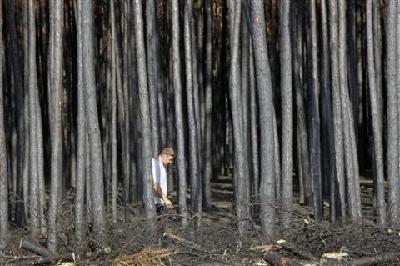
Experts gathered this week in Sun City, South Africa, to discuss wildfires. But a new report also focused on a growing phenomenon called mega-fires.
The report describes mega-fires as "extraordinary conflagrations unprecedented in the modern era for their deep and long-lasting social, economic and environmental impact. They're ignited with the help of climate change and may contribute to it as well.
Pieter van Lierop is a forestry management officer for the UN Food and Agriculture Organization, the FAO. "As a consequence of climate change, climates are getting dryer in many parts of the world. And by becoming dryer, the risk of a fire increases. And [in] most of the mega-fires which we looked at, drought was a contributing factor."
Black Dragon
The FAO commissioned the mega-fire study. The research was led by Jerry Williams, former national director of Fire and Aviation Management of the US Forest Service. He's credited with the concept of mega-fires.
It's believed the mega-fire era began in 1987 with China's Great Black Dragon Fire. The flames killed more than 200 people and blackened 1.2 million hectares. Scientists still find it difficult to calculate the loss in biodiversity or the amount of greenhouse gas emissions released.
Van Lierop, who took part in the study, said the emissions are believed to contribute to climate change.
"The other side of the story is how fires or mega-fires, in general, contribute to climate change through carbon emissions. It seems to all of us there's a very logical relation, but we don't have hard statistical data."
Nature or man?
The study says firefighters often have little chance of controlling mega-fires until they get a favorable change in the weather or the fire begins to run out of fuel. Mega-fires are not always a single wildfire. They can be a complex of fires inter-acting over a wide area.
While the fires are often perceived as an "accident of nature," Van Lierop says that's often not the case.
"Mega-fires, like most other wildfires, are in most cases caused by man – on purpose or out of neglect. There are many reasons for this," said van Lierop.
Other factors include poor forest management and a lack of awareness among the population of the causes of wildfires.
The FAO study examined mega-fires from 1997 to 2010 in eight countries: Indonesia, Brazil, the United States, Greece, Botswana, Australia, Russia and Israel.
The Indonesian mega-fire in 1997 was an act of arson and burned nearly 10 million hectares. A hectare equals 10,000 square meters. It's estimated the fire also pumped 700 million tons of greenhouse gas emissions into the atmosphere.
More to come
The report said urgent action is required because mega-fires are becoming more common.
"If we know that drought is one of the main contributing factors to the mega-fires, and we know that we're getting to a time of climate change where many parts of the world the climate will become dryer, we can expect a lot more mega-fires than we've had until now. Unless, of course, we look at ways [of] how we can better deal with vegetation of forest and landscape in general by maintaining them in a different way and treating them in a different way," said van Lierop.
For example, the building of communities, road systems and recreation areas as part of logging and mining operations lead to efforts to prevent or suppress fires. However, these developments may be located in areas where fires have played a major ecological role over the centuries. Flammable natural materials build up, setting the stage for mega-fires.
conflagration: a very large fire that destroys a lot of land or buildings 大火災(zāi);大火
California fire burns more than 49,000 hectares
(來源:VOA 編輯:崔旭燕)
